26 Jul 2021
Council Funds Bile Beans Repainting in Leeds
Years after the famous case in York, another Bile Beans ghost sign has been repainted, this time in Leeds. A post to Instagram of the picture below polarised opinion in the comments, so I decided to investigate further. What I found provides another useful case study within the context of my extended Restoration Period article.
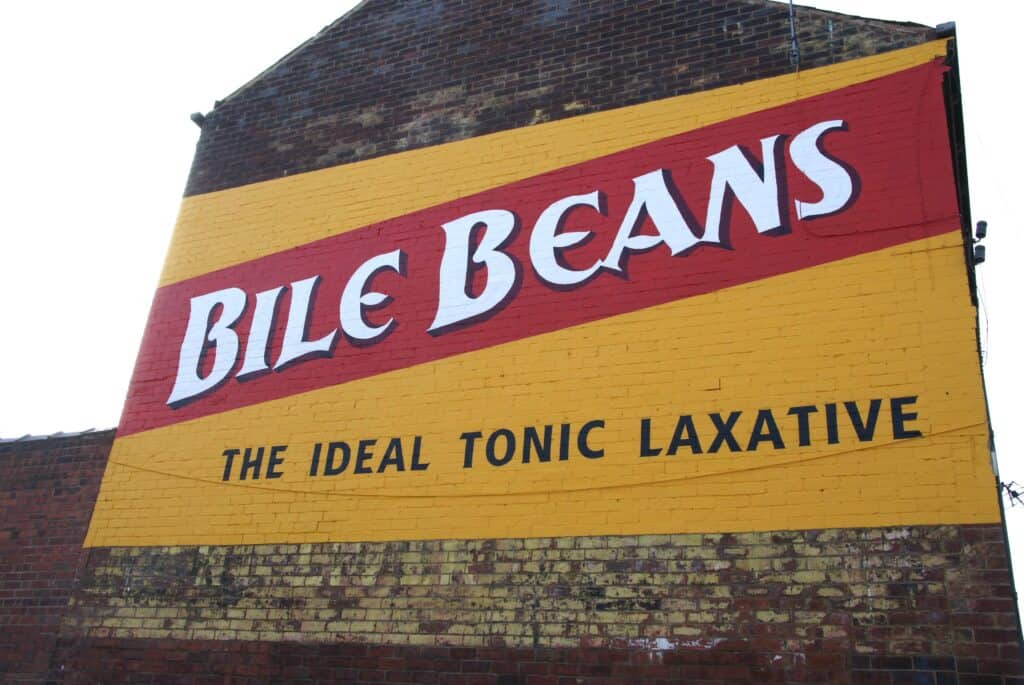
The Back Story
The (original) sign was familiar to me. It featured in this very old blog post and is documented in the History of Advertising Trust Ghostsigns Archive. When processing Richard Turner’s photo below for the archive in 2009 I arrived at the following (partial) transcription: “MEDICALLY… BILE BEANS, THE IDEAL TONIC LAXATIVE”. The sign is located on Balm Road in the Hunslet Carr area of Leeds.
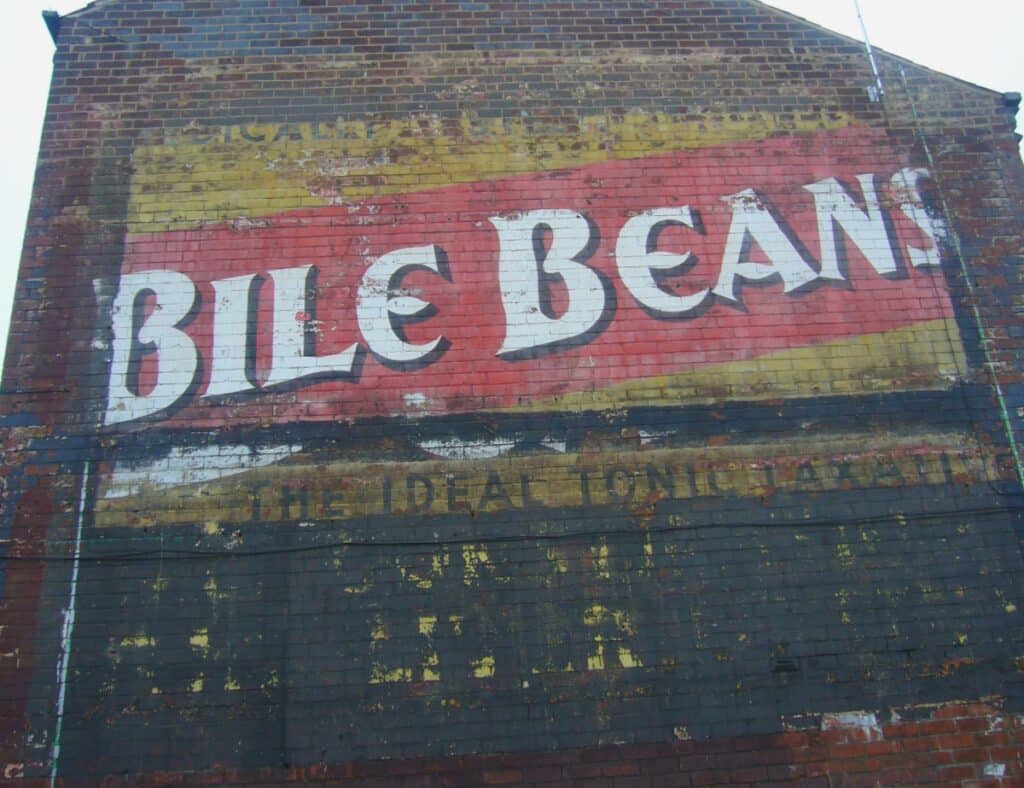
Twelve years after Richard took his photo the sign had decayed significantly. Its partial nature clearly indicates that it was protected by a billboard for many years and, once revealed, the sun went to work. This is something I’ve started noticing frequently now that I have photos of signs ten or more years apart. (The billboards don’t get as much credit as they deserve for their contribution to ghost signs preservation.)
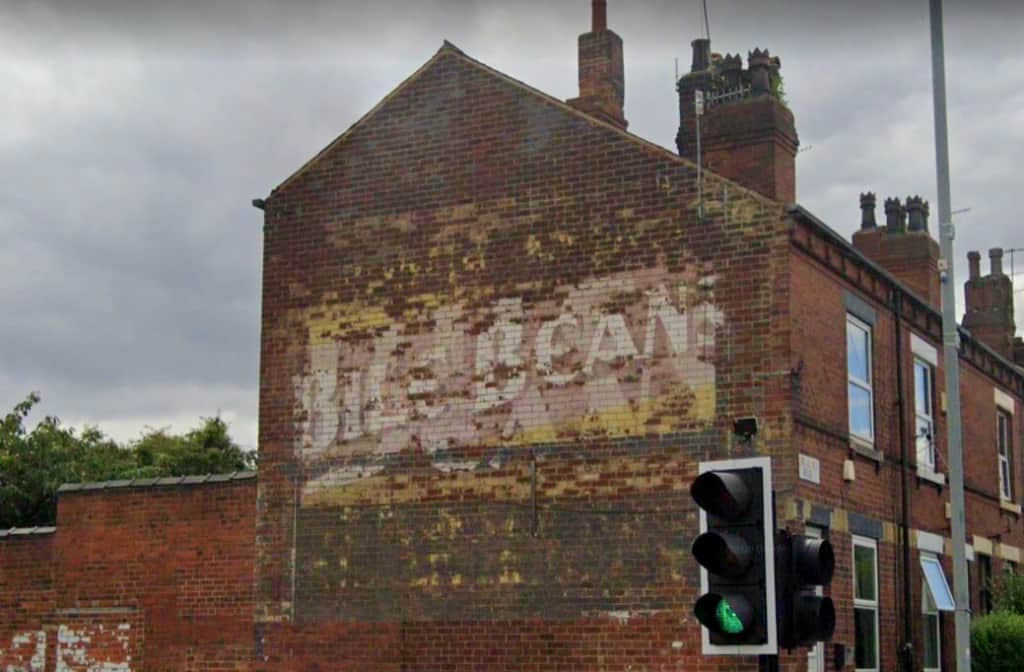
The above photo shows that another sign had begun to show through from underneath, creating a palimpsest. It looks an earlier Bile Beans sign based on what’s visible, with the two words stacked and the lower ‘Beans’ most visible in the same lettering style.
Local Interest and Council Funding
The fading of the sign was noted by locals and came onto the agenda of the Hunslet Carr Residents Association. This led to them making contact with the local Council with a view to getting the sign repainted. In my correspondence with Councillor Paul Wray, he gave this account.
“Areas like Hunslet have lost a significant part of their history and the local residents association came to worry the original sign was deteriorating rapidly to the point of non-visibility and thus preserving the sign in its current state was not viable. But they also did not want an element of local history to be lost either. They therefore asked Councillors if they would fund the cost of a restoration rather than preservation to which we agreed.”
Cllr Paul Wray, Labour Councillor for Hunslet and Riverside Ward
He went on to add.
“We fully accept the strong views of some that the sign should have been preserved rather than restored or left to fade completely. If the request to preserve had been made when the sign was originally uncovered, preservation would have been the likely outcome as it was in a much brighter and more visible condition.”
Cllr Paul Wray, Labour Councillor for Hunslet and Riverside Ward
It’s interesting to see that the objective of the funding decision would probably have been different if the request from the residents group had come earlier on. I’m going to talk a little about freezing ghost signs in a state of ‘arrested decay’ in the book. Ultimately it is one of a number of approaches that can be taken, with touching up while retaining the faded aesthetic being another.
This Council funding was used to commission mural artist, Peter Barber, to repaint the sign. Although I don’t remember it being in the context of this sign, Peter did call me to ask some questions about the project. My main piece of advice was to ensure that good quality photography of the sign was taken before he started work. This was done, although I don’t know where the photos will be lodged, hopefully a local archive such as Leodis.
The Repainting Work
Peter’s work followed a fairly standard procedure of taking tracings of the design from the wall. High-pressure steam was then used to clean loose paint from the old signs. The background colours were put down, before using the tracings to transfer the design back onto the wall ahead of painting.
There’s some video footage of this work-in-progress on Peter’s Instagram story documenting the process from start to finish. I’ve taken some screengrabs for the benefit of those that don’t use Instagram.
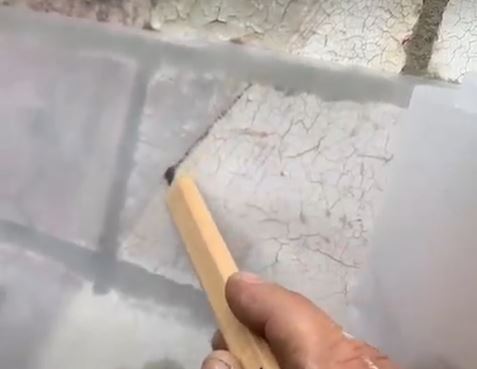
Taking tracings of the original sign 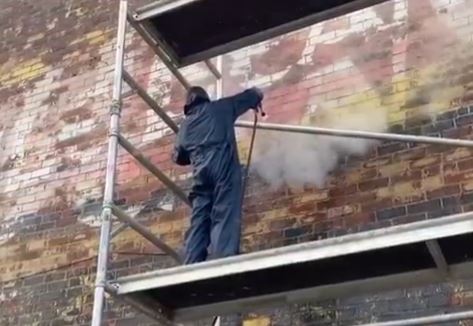
Steaming loose paintwork 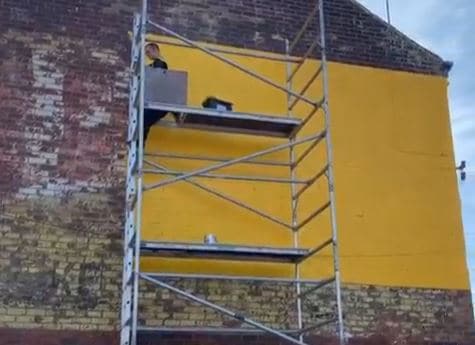
Laying down the background 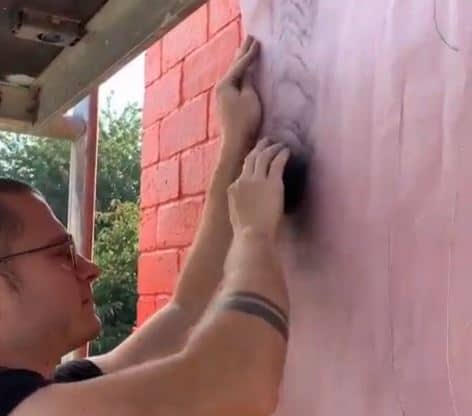
Transferring (pouncing) the design 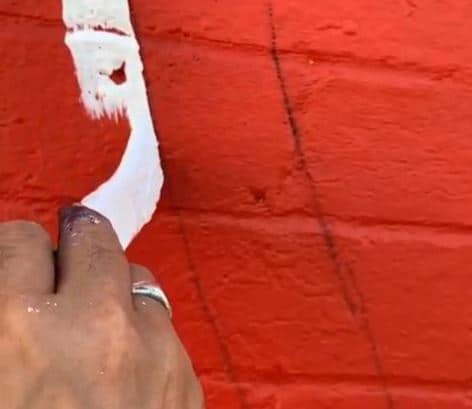
Repainting the main lettering 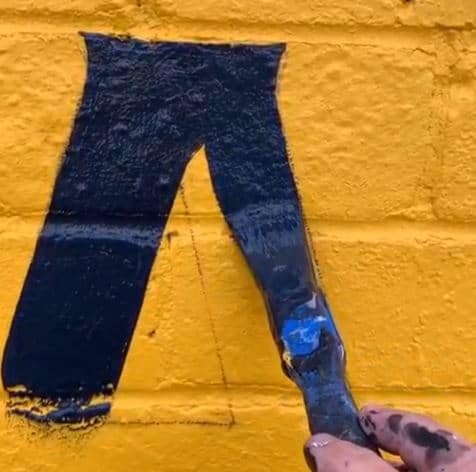
Repainting the secondary copy
Given that the sign was, by this point, a palimpsest, a choice was made to repaint the most recent, and visible, layer. (The same decision will be needed if this campaign in Bristol is successful.) Peter notes:
“I took direct tracings from the wall for the pounce patterns which is why the most recent version was used. In later Bile Bean adverts the messaging was more conservative about medical claims and I chose to only reinstate the text I could see and trace.”
Peter Barber
I think that he would have been justified in painting more than what was explicitly visible at the time he took to the wall. As we’ve seen above, there are older photos that would have given more copy, and possibly archival images elsewhere. I think that these types of searches should be a requisite part of any repainting effort. For example, a search on the known terms for this sign in Leeds throws up this wonderful image from Wolverhampton which looks to be a contemporary advertisement. (It comes from an article about the Harrington family of signwriters which I recommend reading.)
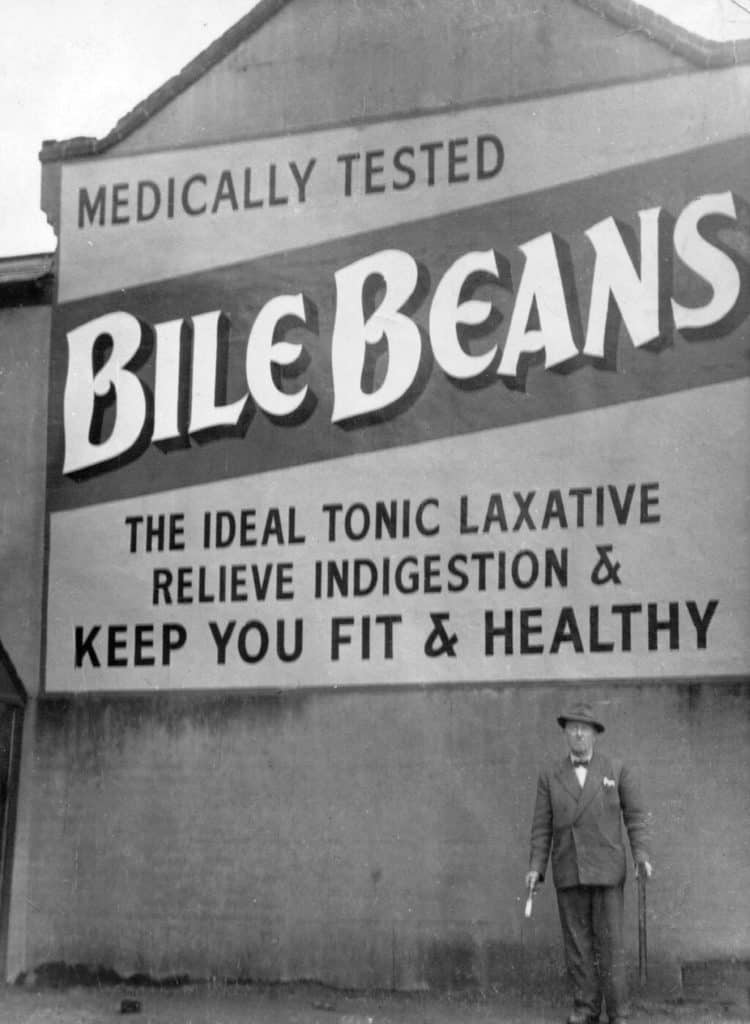
There are other Bile Beans ghost signs, but none match up with this one in terms of the precise copy and layout. (See the History of Advertising Trust Ghostsigns Archive.) However, it’s clear from the surviving paintwork on the wall that the design extended further downwards, and that there was copy above the main Bile Beans logotype. I think that more could have been done to figure these areas out, and to include them in the repainting. (While it is an extreme example, the F.C. Dyson repainting in Stoke Newington shows the pitfalls of partial repainting efforts.)
Public Reaction
Something that I’ve never really delved into in great depth is the question of who these repaintings are for. And, related to that, who can judge the success, or otherwise, of any given project. My opinion as a detached and critical observer of these things probably doesn’t count for much versus those that pass these signs every day. However, as the comments on my Instagram post showed, opinion is often divided, and so it isn’t necessarily a case of the public versus the semi-professional voyeur.
In responding to my questions, both the mural painter Peter Barber and Councillor Paul Wray gave their views on the local reception to the repainting work.
“I must say that the reception of the people I met was overwhelmingly positive.”
Peter Barber
“The overwhelming view of the local public since it has been completed has been positive and it has created a local landmark for the area – adding a significant splash of colour. On this basic, it is felt the project has been very positive for the local area.”
Cllr Paul Wray, Labour Councillor for Hunslet and Riverside Ward
Further local comment on the work can be found in the comments section of an article in South Leeds Life. Here are two that give a sense of how polarised these are, and that there isn’t a coherent public opinion on the matter.
“I Love the ‘restoration’ and a nice visual when driving into the area… Well done to all the people involved and especially those who initiated the project.”
Antony
“The sign hasn’t been restored it’s been vandalised. It’s only vaguely reminiscent of the original.”
Stephen Topp
The other comments are split roughly evenly along these lines, with one citing the missed opportunity to create a brand new, original artwork on the wall. I’ve often said that we should invest in painting pieces today that will become tomorrow’s ghost signs. Frank Jump even testified to this effect in New York.
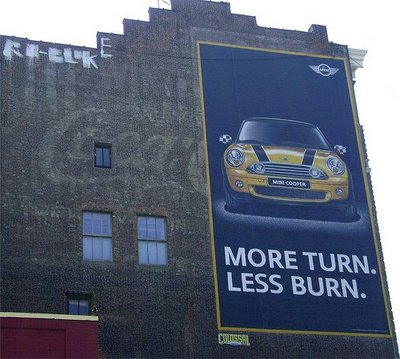
What Next?
The South Leeds Life article points out that Bile Beans themselves were manufactured in Leeds, and so there is a pertinent local historical dimension to the project. This has led to the council deciding to place the repainting in context.
“The Council is funding the creation of a historic lectern with high-definition photos of the faded sign with descriptions – helping to ensure future residents understand the history of the sign.”
Cllr Paul Wray, Labour Councillor for Hunslet and Riverside Ward
I think this is a good idea, and one that I have recommended before. Plaques beneath ghost signs, that draw attention to them, could be an excellent way of celebrating them while they are still around. These could include historical notes, archival photos, and scale reproductions to show what they might have looked like when the paint was fresh. It also be possible to bolt on technology like augmented reality to display work such as Craig Winslow’s Light Capsules.
If you liked this article, and want to see more in the future, please contribute to my work below. Read more posts on restoration, including my extended Restoration Period essay.
Thank you to Councillor Paul Wray, Peter Barber and Lyn Bambury for their assistance in researching this case study of a Bile Beans ghost sign repainting in Leeds.


